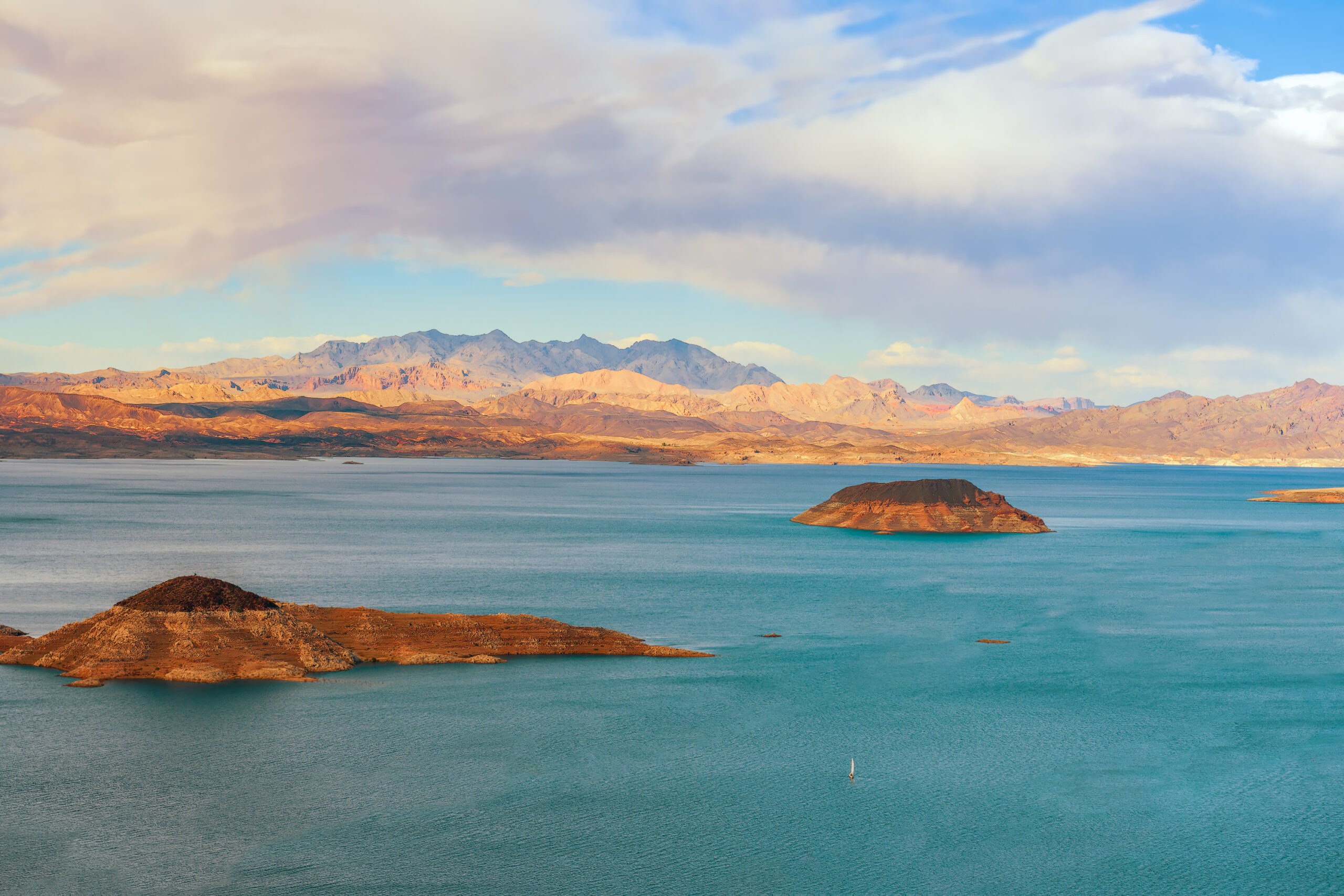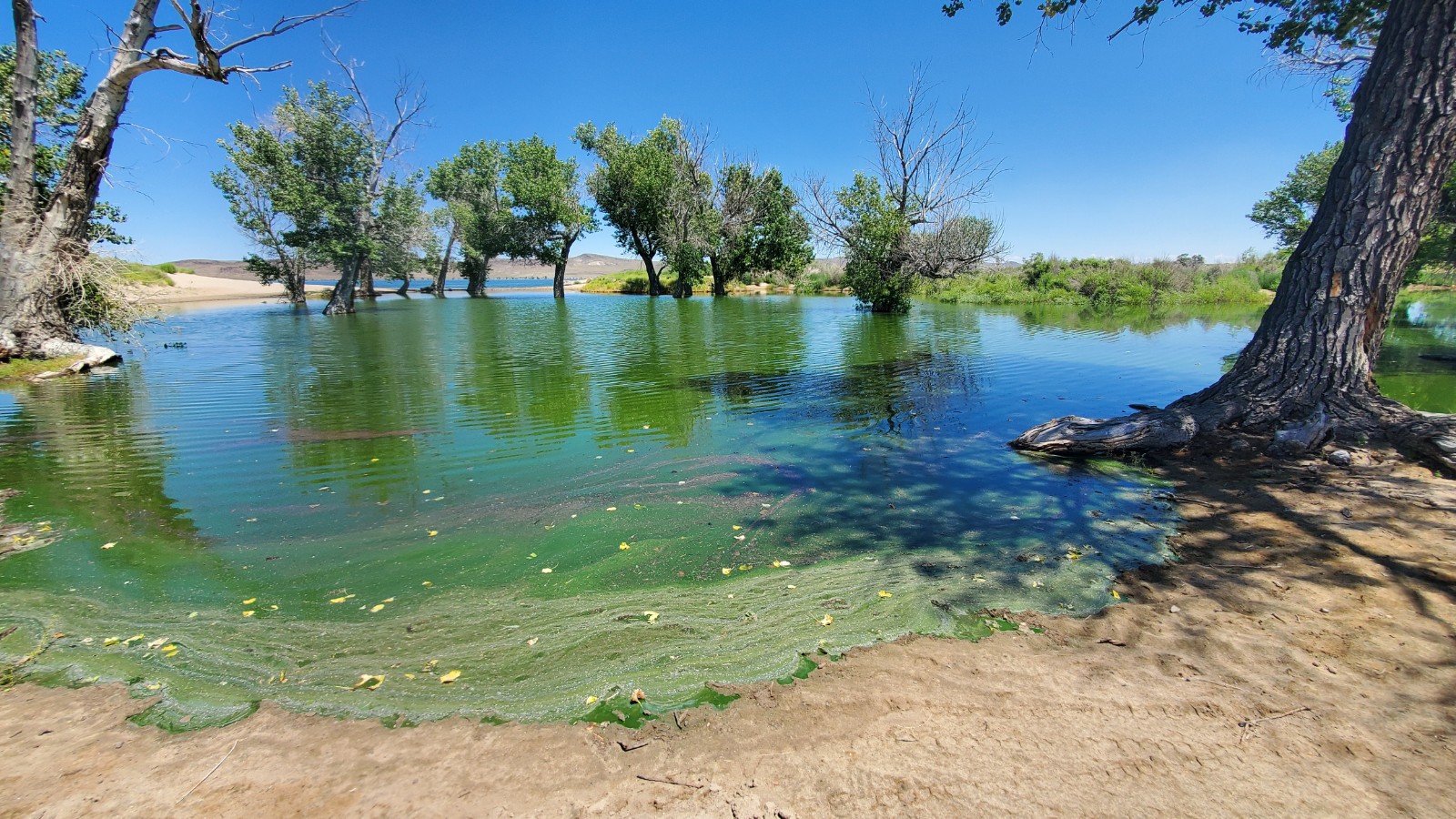
DATA
Harmful Algal Blooms (HABs) Data
Access our HAB dashboard which shows current data on active HABs in bodies of water in Nevada including any advisory levels.
Environmental Health
Harmful Algal Blooms
What are Harmful Algal Blooms?
Harmful algal blooms (HABs) form when naturally occurring blue-green algae multiply quickly and cause discoloration, scum, and mats on the water. Blue-green algae are not actually algae, they are single-celled aquatic organisms called cyanobacteria that are closely related to bacteria and can photosynthesize like algae. These microorganisms have been a natural part of aquatic ecosystems for thousands of years. Although most algal blooms are not toxic, some types of cyanobacteria produce nerve or liver toxins. Toxicity can be hard to predict because a single species of algae can have both toxic and non-toxic strains, and a bloom that tests non-toxic one day can be toxic the next. Because it is hard to tell whether an algal bloom is harmful or not it is recommended to avoid contact with any floating mats, scums, and discolored water.
Blooms in Nevada occur in freshwater, such as lakes, ponds, streams, and rivers. They can occur any time throughout the year although the conditions that lead to harmful algal blooms generally occur in the late summer and early fall. These conditions include:
- High nutrient levels
- Abundant sunlight
- Warm water temperatures
- Stagnant or slow-moving waters
If these conditions are present for several days, cyanobacteria can multiply to form large blooms that can cover an entire lake or collect in smaller areas. Blooms generally die and disappear after one or two weeks.
What do Harmful Algal Blooms look like?
Harmful algal blooms can look like pea soup, foam, spilled paint, grass clippings, or mats on the surface of water and can be different colors.

If you suspect a harmful algal bloom, you can take the following precautions:
- Don’t swim in the water.
- Don’t boat, water ski, or jet-ski on scummy water. These activities can cause toxins to become airborne, increasing the likelihood you will inhale them.
- Don’t let children play with scum on the water or along the shore.
- Don’t let pets or livestock swim in or drink from scummy water.
- Don’t boil the water in an attempt to remove toxins as boiling can release more toxins.
Regardless of a harmful algal bloom people should take the following precautions every time they have contact with recreational lakes, ponds, streams, or rivers:
- Check for local and state swimming or fishing advisories prior to visiting lakes, rivers etc.
- Don’t swallow water when swimming.
- Shower after coming into contact with recreational water.
- Rinse animals immediately if they swim in recreational water.
- Wash hands with clean water before eating or preparing food.
- Clean waterfowl and fish well with clean water and discard the guts.
- Never drink recreational water.
- Wash dishes with clean water. Do not use recreational water.
- When in doubt, stay out.
What are the symptoms of exposure to a Harmful Algal Bloom?
When people are exposed to cyanotoxins, adverse health effects may range from a mild skin rash to serious illness or in rare circumstances, death. People exposed through direct skin contact, ingestion or inhalation may experience irritation of the skin, eyes, nose, throat, and/or respiratory tract. Symptoms to look for include:
- Rashes, hives, or blisters
- Runny nose, sore throat, asthma, or allergic-like reactions
People exposed through ingesting cyanotoxins may experience:
- Abdominal pain
- Headache
- Neurological symptoms
- Vomiting
- Diarrhea
- Liver damage and/or kidney damage
Where do I report possible exposure?
- If you are experiencing symptoms after being exposed to a harmful algal bloom, contact your physician, and seek care immediately.
- If your pet is exhibiting signs of illness after being exposed to a harmful algal bloom, contact a veterinarian, and seek care immediately.
- Report harmful algal blooms to Nevada Department of Environmental Protection (NDEP): 888-331-6337
- Report sick or dead wildlife to Nevada Department of Wildlife (NDOW): 775-688-1500
- If you have any questions about cyanobacterial toxin poisoning, call Poison Control at 1-800-222-1222
- Report human and domestic animal illnesses, email stateepi@health.nv.gov.
How do I protect my pets against Harmful Algal Blooms and what exposure symptoms should I watch for?
Pets and companion animals can be exposed to cyanobacteria or toxins by skin contact with contaminated water, when swallowing contaminated water while playing in the water, or by licking it off fur or hair. It is important not to let pets play, swim, or drink water that smells bad, has a strange color, appears slimy, foamy, or has mats or scum. It is advisable that you do not let your pet eat dead animals, such as fish found near the bloom or eat mats of cyanobacteria. Prevention is the best way to protect pets because most exposures are fatal even with proper veterinary care.
If you think your pet or companion animal has been exposed to a harmful algae bloom rinse them off immediately in clean fresh water. Wear gloves while rinsing your pet to protect yourself from exposure. Watch for symptoms that pets may exhibit after being exposed to cyanotoxins. Symptoms can arise anywhere from 15 minutes to several days after exposure. Take pets to the vet immediately if they show any of these signs:
- Weakness
- Staggering
- Difficulty breathing
- Drooling
- Vomiting
- Diarrhea
- Convulsions
- Loss of appetite
- Foaming at the mouth
- Excessive drooling
- Tremors and seizures
One Health Harmful Algal Bloom System (OHHABS)
OHHABS is a surveillance system use to gather information about people, animals, and the environment. The information gathered helps the Centers for Disease Control and Prevention (CDC) and state/federal partners better understand HABs and help prevent human and animal illnesses caused by HABs. The information reported to OHHABS by states and territories also assist in defining patterns of occurrence, safeguarding water and food supplies, and communicating with the public to prevent future illnesses. Nevada is one of 18 states that participates in this reporting system.
OHHABS can help describe:
- How many humans and animals are exposed to HABs per year.
- Symptoms of diseases brought on by HAB exposure.
- Where diseases and HABs are occurring throughout the United States.
- HABs and wildlife – NDOW
OHHABS Reporting
The primary reporters to OHHABS are the health departments in the U.S states and territories. In most instances, health departments report directly in OHHABS, but they can sometimes assign other partners to report. OHHABS can gather information about HABs in fresh or salt water as well as any associated human or animal illnesses. HABs can be reported on their own if no diseases in humans or animals are found. The main categories for reporting are HABs, food sources, human and animal illnesses.
To find data about HABs and associated human and animal illnesses, click here
For more information about OHHABS, click here
Resources
General HAB Resources
- Harmful Algal Blooms and Your Health | CDC
- Preventing Illnesses Caused by Harmful Algal Blooms | CDC
HAB Toolbox Posters
- Posters | Harmful Algal Blooms | CDC
- Poster | Be Algae Aware | CDC
- Graphics | Harmful Algal Blooms | CDC
Definitions*
Photosynthesize: a process that plants, algae, and some bacteria use to turn sunlight, carbon dioxide and water into sugar and oxygen
Nutrient: any substance that provides nourishment necessary for development and life maintenance.

Harmful Algal Blooms (HABs) Alerts
REPORTS of ACTIVE HABs in NEVADA
To access a list and visual observation of current and historical affected water bodies by HABs, please click below.

